- Home
- Susan Wittig Albert
Queen Anne's Lace
Queen Anne's Lace Read online
China Bayles Mysteries by Susan Wittig Albert
THYME OF DEATH
WITCHES’ BANE
HANGMAN’S ROOT
ROSEMARY REMEMBERED
RUEFUL DEATH
LOVE LIES BLEEDING
CHILE DEATH
LAVENDER LIES
MISTLETOE MAN
BLOODROOT
INDIGO DYING
A DILLY OF A DEATH
DEAD MAN’S BONES
BLEEDING HEARTS
SPANISH DAGGER
NIGHTSHADE
WORMWOOD
HOLLY BLUES
MOURNING GLORIA
CAT’S CLAW
WIDOW’S TEARS
DEATH COME QUICKLY
BITTERSWEET
BLOOD ORANGE
THE LAST CHANCE OLIVE RANCH
QUEEN ANNE’S LACE
AN UNTHYMELY DEATH
CHINA BAYLES’ BOOK OF DAYS
Cottage Tales of Beatrix Potter Mysteries by Susan Wittig Albert
THE TALE OF HILL TOP FARM
THE TALE OF HOLLY HOW
THE TALE OF CUCKOO BROW WOOD
THE TALE OF HAWTHORN HOUSE
THE TALE OF BRIAR BANK
THE TALE OF APPLEBECK ORCHARD
THE TALE OF OAT CAKE CRAG
THE TALE OF CASTLE COTTAGE
Darling Dahlias Mysteries by Susan Wittig Albert
THE DARLING DAHLIAS AND THE CUCUMBER TREE
THE DARLING DAHLIAS AND THE NAKED LADIES
THE DARLING DAHLIAS AND THE CONFEDERATE ROSE
THE DARLING DAHLIAS AND THE TEXAS STAR
THE DARLING DAHLIAS AND THE SILVER DOLLAR BUSH
THE DARLING DAHLIAS AND THE ELEVEN O’CLOCK LADY
With her husband, Bill Albert, writing as Robin Paige
DEATH AT BISHOP’S KEEP
DEATH AT GALLOWS GREEN
DEATH AT DAISY’S FOLLY
DEATH AT DEVIL’S BRIDGE
DEATH AT ROTTINGDEAN
DEATH AT WHITECHAPEL
DEATH AT EPSOM DOWNS
DEATH AT DARTMOOR
DEATH AT GLAMIS CASTLE
DEATH IN HYDE PARK
DEATH AT BLENHEIM PALACE
DEATH ON THE LIZARD
Other books by Susan Wittig Albert
WRITING FROM LIFE
WORK OF HER OWN
A WILDER ROSE
LOVING ELEANOR
THE GENERAL’S WOMEN
BERKLEY PRIME CRIME
Published by Berkley
An imprint of Penguin Random House LLC
375 Hudson Street, New York, New York 10014
Copyright © 2018 by Susan Wittig Albert
Penguin Random House supports copyright. Copyright fuels creativity, encourages diverse voices, promotes free speech, and creates a vibrant culture. Thank you for buying an authorized edition of this book and for complying with copyright laws by not reproducing, scanning, or distributing any part of it in any form without permission. You are supporting writers and allowing Penguin Random House to continue to publish books for every reader.
BERKLEY is a registered trademark and BERKLEY PRIME CRIME and the B colophon are trademarks of Penguin Random House LLC.
Library of Congress Cataloging-in-Publication Data
Names: Albert, Susan Wittig, author.
Title: Queen Anne’s lace / Susan Wittig Albert.
Description: First edition. | New York, NY : Berkley Prime Crime, 2018. |
Series: China Bayles mysteries
Identifiers: LCCN 2017028400 (print) | LCCN 2017031280 (ebook) | ISBN 9780698190306 (eBook) | ISBN 9780425280058 (hardcover)
Subjects: LCSH: Bayles, China (Fictitious character)—Fiction. | Women detectives—Texas—Fiction. | GSAFD: Mystery fiction.
Classification: LCC PS3551.L2637 (ebook) | LCC PS3551.L2637 Q44 2018 (print) |
DDC 813/.54—dc23
LC record available at https://lccn.loc.gov/2017028400
First Edition: April 2018
Cover art: Illustration copyright © by Joe Burleson; Lace background copyright © by Sh.Olga/Shutterstock
Cover design by Judith Murello
This is a work of fiction. Names, characters, places, and incidents either are the product of the author’s imagination or are used fictitiously, and any resemblance to actual persons, living or dead, business establishments, events, or locales is entirely coincidental.
PUBLISHER’S NOTE: The recipes contained in this book are to be followed exactly as written. The publisher is not responsible for your specific health or allergy needs that may require medical supervision. The publisher is not responsible for any adverse reactions to the recipes contained in this book.
Version_1
For Natalee Rosenstein, gratefully
Contents
Also by Susan Wittig Albert
Title Page
Copyright
Dedication
Prologue
Chapter One
Chapter Two
Chapter Three
Chapter Four
Chapter Five
Chapter Six
Chapter Seven
Chapter Eight
Chapter Nine
Chapter Ten
Chapter Eleven
Chapter Twelve
Chapter Thirteen
Chapter Fourteen
Chapter Fifteen
Author’s Note
Recipes
About the Author
Prologue
Pecan Springs, Texas
1885
It was a mistake to think of houses, old houses, as being empty. They were filled with memories, with the faded echoes of voices. Drops of tears, drops of blood, the ring of laughter, the edge of tempers that had ebbed and flowed between the walls, into the walls, over the years. Wasn’t it, after all, a kind of life?
Key of Knowledge, Nora Roberts
If Annie Laurie’s house could speak, it would have said that she was a contented woman.
She rose before the sun every morning to prepare her husband’s breakfast. Douglas always went out to his blacksmith shop the very first thing, to see that the fire was started in the forge and his smithy helpers were at their tasks. Then he would come in for the good food Annie had ready for him—eggs and bacon, grits, and biscuits with redeye gravy—before he began the day’s work. And there was always plenty of work to do, because Douglas Duncan was the best blacksmith in the village of Pecan Springs, Texas. Annie wasn’t the only one who had this opinion, and to prove it, there were the customers lined up waiting in the dusty alley behind their house at 304 Crockett Street, eager to have their horses shod or their implements mended or their wagon wheels repaired.
Their house. Annie loved the house Douglas had built for her. It was a fine, two-story dwelling with walls made of square-cut limestone blocks and a white-painted wood-frame veranda across the front, draped with ivy and honeysuckle. Behind the veranda were two large rooms side-by-side, one of them a sitting room, the other a dining room, with high ceilings and tall, deep-set windows in the outer walls. Behind them were a bedroom and a large kitchen and pantry. Above, there was a full second-story loft that Annie and Douglas planned to partition into bedrooms for their children.
The house was in a lovely setting, too. It faced Crockett Street, which was lined on both sides by large live oak trees that ma
de a graceful canopy over the brick pavement. On the east side of the house was a garden, and behind it on the alley were Douglas’ smithy and the commodious stone stable where he kept his sleek, spirited horse and a shiny black buggy with red-painted wheels. On the other side of the garden hedge was a large, yellow-painted frame house where Adam and Delia Hunt lived with their little girl, Caroline. Adam Hunt had been Douglas’ best friend since their boyhood days and the two men often went fishing and hunting together.
All day long, as she went about her own activities, Annie could hear the musical clang clang clang of Douglas’ hammer, and her heart swelled with happiness. Her husband was an excellent provider. He gave her a generous household allowance and hired a woman to do the cooking and the laundry so that, when Annie’s housework was done, she could spend the rest of day doing what she most loved: making fine laces. For Annie, lacemaking was a challenging craft that kept her fingers nimble and her mind sharp, while Douglas saw it as a dainty lady’s hobby that gave his wife something to keep her hands busy before she became occupied with a growing family.
But in the Duncan household, all was not work. On mild Sundays, Douglas would drive them in the buggy west along the Pecan River. Or north, to the village of San Marcos, or east across the San Antonio Road to the blackland prairie. Or they might take a picnic basket to the spring, where they spread a blanket in the shade, ate Annie’s fried chicken, and enjoyed the breeze while Douglas played his guitar and sang. His father and mother had come to America from Scotland, and he loved the old Scottish ballads—“Highland Mary,” “My Love Is Like a Red, Red Rose,” and his favorite, which always brought tears to Annie’s eyes:
Maxwelton’s braes are bonnie
Where early falls the dew
And it was there that Annie Laurie
Gave me her promise true
Gave me her promise true
Which never forgot will be
And for bonnie Annie Laurie
I would lay me down and die.
Annie hoped to give Douglas the son he wanted, but it had taken many months to conceive. While she was waiting, she continued to make lace—such beautiful lace that, while at first she gave it away, her friends and their friends soon clamored to buy it. Douglas wasn’t a man to be offended if his wife brought in a little extra money doing something she enjoyed, and he allowed her to keep what she earned. It gave her great pleasure to use it to buy little things for the house and for Douglas and herself: a white silk parasol, for instance, that she trimmed with frills of her very own lace.
But Annie was impatient to get her family started, so one afternoon shortly after their third anniversary, she walked down Crockett Street to call on Mrs. Jane Crow, who ran a boardinghouse on the next block. A plump, kindly woman with brown hair pinned up in a shaggy knot, Mrs. Crow had hung a sign on her porch rail: Herbs & Herbal Remedies For Sale. She grew a great many herbs in the garden behind her house and sold them to Mr. Jackson, the village pharmacist, and to anyone else who came to her with a request.
Annie found Mrs. Crow sitting in a rocking chair on the porch with her knitting, a kitten playing with the ball of yarn at her feet. “What can I help you with, my dear?” Mrs. Crow asked.
“I’d like to buy some herbs,” Annie said. Her mother was dead and her aunts lived far away, but she remembered hearing them talk about plants that were useful to women in their childbearing years—plants that could help you conceive. Or could help if your monthly was late, or too heavy or too scanty, or didn’t come at all.
“What exactly are you looking for?”
“Red clover, perhaps,” Annie said. “And nettle and yarrow, too, I think.” She paused, frowning. “I’m sure there’s something else, but I can’t quite remember—”
“Ah.” Mrs. Crow picked up her ball of yarn and pushed her needles into it. “You and your husband are wanting a baby?”
“Yes,” Annie said, relieved that she wouldn’t have to go into a long explanation.
Mrs. Crow stood up. “I think I have what you’re looking for, my dear. Of course, there are no guarantees, but we can try to give nature a bit of a boost.”
A little later, Annie was on her way home with a large paper packet of dried herbs. On it was written: Red clover, nettle, evening primrose, chaste berry, yarrow. Pour boiling water over a spoonful in a cup and steep for fifteen minutes. Drink twice a day.
Annie brewed Mrs. Crow’s tea, drank it as prescribed for several weeks, and was delighted when her next monthly didn’t appear at the usual time. She waited until she missed the second, then sat down and wrote a thank-you note to Mrs. Crow. When her husband came in from the smithy that evening, she told him. He caught her up in his arms and whirled her around in an excited dance.
“A baby!” he cried. “Our baby. Oh, Annie, my dearest, dearest Annie, I love you!”
And then it seemed to Annie that their house was filled with such a great happiness that it should surely burst. Douglas never stopped smiling and she went about her work with a joyful song on her lips.
Later, she would tell herself that it was a very good thing that she couldn’t look into the future and see what lay ahead. After the worst had happened, she would look back on those days with a wistful longing, wishing with all her heart that she could have held on to the good times and kept them with her forever.
Of course she couldn’t. None of us can. But we can try.
Annie tried.
Chapter One
Queen Anne’s lace (Daucus carota, aka wild carrot) traveled to America from Europe and hopscotched across the continent with a recklessly joyful abandon. Some herbalists speculate that its use as a morning-after contraceptive made Queen Anne’s lace a valuable must-have herb for pioneer women, so they made sure to carry the seeds with them wherever they went. With this in mind, I suppose it’s no surprise that we find this plant growing everywhere—along roads and in ditches, in farmers’ fields and urban backyards.
Queen Anne’s lace earned its common name from the lacelike delicacy of its doily-shaped white blossoms, each of which is centered with a single, tiny bloodred flower.
“Anne’s Flower”
China Bayles
Pecan Springs Enterprise
I love Mondays. I really do.
Thyme and Seasons is closed on Monday and I can slop around in my grubbiest jeans and T-shirt, doing all the housekeeping I can’t do when customers are asking for my attention every few minutes. On Monday, there’s time to appreciate the old stone walls, the well-worn wooden floors, and the beamed ceilings that create a lovely setting for my herbal wares. I can dust the antique hutch and wooden shelves stocked with herbal vinegars, oils, jellies, and teas. I can rearrange the books in the bookshelf and tidy up the old pine cupboard that displays bath herbs, herbal soaps and shampoos, fragrances, and massage oils. I can restock the wooden rack that holds the bottles of extracts and tinctures and the large glass jars of dried culinary and medicinal herbs. I can rearrange the wreaths and swags on the walls and reorganize the buckets of fragrant potpourri in the corners, as well as tall stalks of dried sunflowers, baskets of dried Queen Anne’s lace, Silver King artemisia, yarrow, and tansy. And when the weather’s good, I can work outdoors in the herb gardens around the shop and replenish the shelves of potted herbs for sale—basil, parsley, sage, rosemary, thyme, chives—outside my front door.
No offense to my friends and customers: I enjoy you, and if I want to stay in the herb business, I need you. But if I were Queen of the World, it would be Monday all week long.
This particular August Monday was hot and steamy, so I worked outdoors for less than an hour, pulling weeds, trimming plants, and cutting some parsley, thyme, and rosemary for the tearoom kitchen. Then I cooled off with a little dusting and tidying up and planned to spend the rest of the morning peeking at my monthly income and expense reports, reviewing the tearoom menus that Ruby and Cass had proposed for the next
couple of weeks, checking out a couple of things on the website, and looking over the handouts for September’s classes on wreath-making. Lovely things. Lovely Monday things.
With this in mind, I took my laptop to the counter and sat down on my stool. Khat—our shop Siamese and quite an autocratic creature—jumped up beside me, placing a proprietary paw on the computer keyboard and watching with interest while I pulled up the previous month’s financial data. I didn’t need a degree in economics to see that while July’s bottom line wasn’t quite red, it wasn’t quite as black as it should be. Sales had been a little slow, and on top of that, I had paid a couple of sizeable bills for the loft renovation, which happened because I decided that the empty space over our heads really ought to be generating some income. There was also a big bill for the veranda construction, which was rather a whim but has made an attractive difference in the street appearance of our shops.
I knew my building was old—well over a hundred years—but I didn’t know much about its history. It has been extensively remodeled, of course, but it was originally built, I’ve learned, as a house. When I started planning the loft project, I happened to look at a photograph from the early 1900s and discovered that there had once been a wood-frame veranda across the front. I loved that veranda at first sight. No matter how much it cost, I had to have it.
And when the job was done and the building looked very much the way it did when it was first built, the Pecan Springs Historical Society installed a handsome plaque beside the front door. It says The Duncan House, 1882—Duncan, the name of the family who originally built the house. Jessica Nelson, a reporter from Pecan Springs Enterprise, wrote an interesting article on its history, with photos. I’ve framed it, and it’s hanging on the wall behind my counter.
The loft is finished, too, and rented to Lori Lowry, a textile artist who uses it as a studio and teaching space. Which is a good deal for Ruby and me, for on top of the rental income, Lori’s students like to browse through our shops and stop for lunch in our tearoom. The local weavers’ guild is planning a show there in October, which will mean even more traffic.

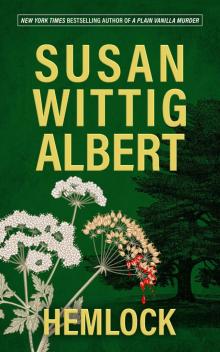 Hemlock
Hemlock Chile Death
Chile Death The Tale of Briar Bank
The Tale of Briar Bank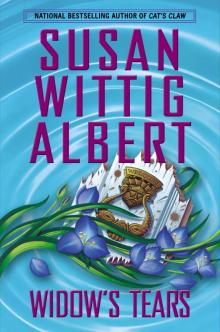 Widow's Tears
Widow's Tears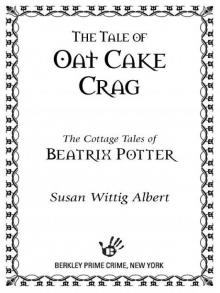 The Tale of Oat Cake Crag
The Tale of Oat Cake Crag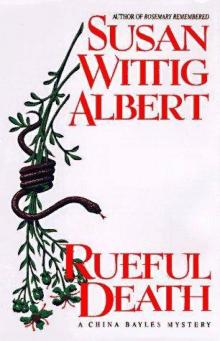 Rueful Death
Rueful Death Bittersweet
Bittersweet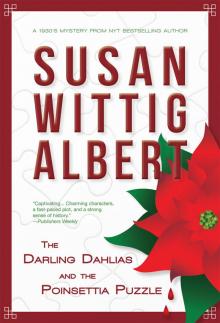 The Darling Dahlias and the Poinsettia Puzzle
The Darling Dahlias and the Poinsettia Puzzle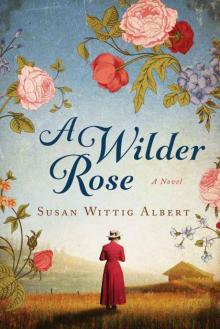 A Wilder Rose: A Novel
A Wilder Rose: A Novel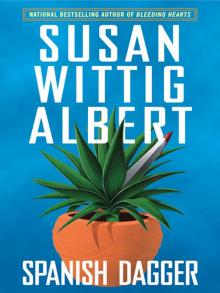 Spanish Dagger
Spanish Dagger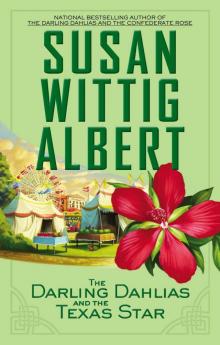 The Darling Dahlias and the Texas Star
The Darling Dahlias and the Texas Star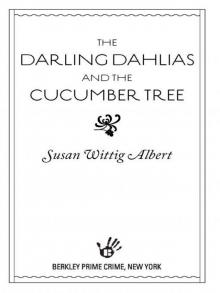 The Darling Dahlias and the Cucumber Tree
The Darling Dahlias and the Cucumber Tree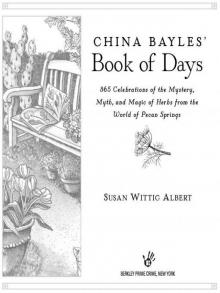 China Bayles' Book of Days
China Bayles' Book of Days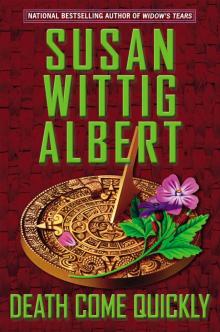 Death Come Quickly
Death Come Quickly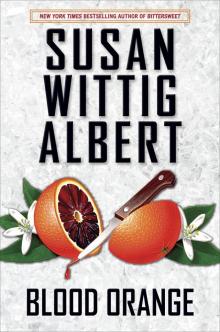 Blood Orange: A China Bayles Mystery
Blood Orange: A China Bayles Mystery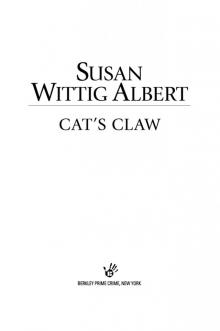 Cat's Claw
Cat's Claw The Darling Dahlias and the Naked Ladies
The Darling Dahlias and the Naked Ladies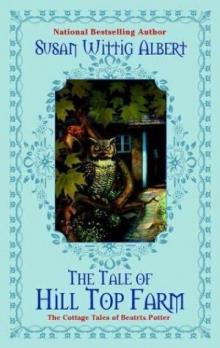 The Tale of Hill Top Farm
The Tale of Hill Top Farm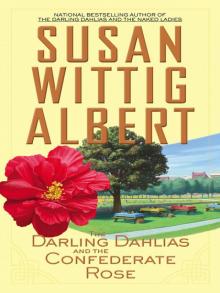 The Darling Dahlias and the Confederate Rose
The Darling Dahlias and the Confederate Rose The Darling Dahlias and the Silver Dollar Bush
The Darling Dahlias and the Silver Dollar Bush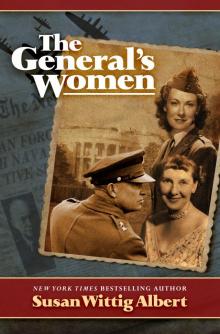 The General's Women
The General's Women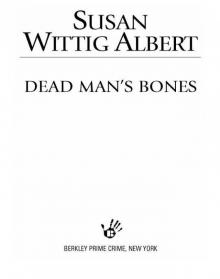 Dead Man's Bones
Dead Man's Bones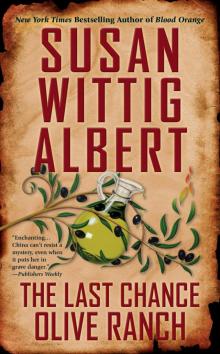 The Last Chance Olive Ranch
The Last Chance Olive Ranch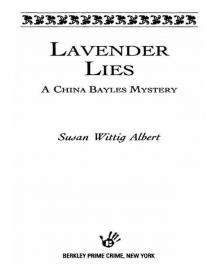 Lavender Lies
Lavender Lies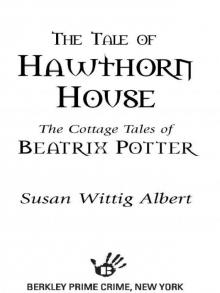 The Tale of Hawthorn House
The Tale of Hawthorn House The Tale of Castle Cottage
The Tale of Castle Cottage Rosemary Remembered - China Bayles 04
Rosemary Remembered - China Bayles 04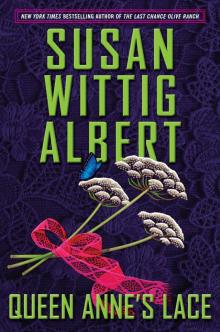 Queen Anne's Lace
Queen Anne's Lace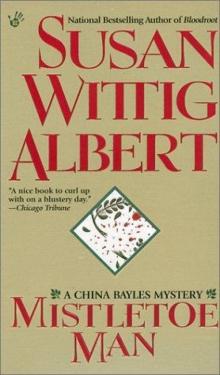 Mistletoe Man - China Bayles 09
Mistletoe Man - China Bayles 09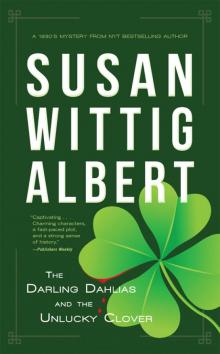 The Darling Dahlias and the Unlucky Clover
The Darling Dahlias and the Unlucky Clover Mourning Gloria
Mourning Gloria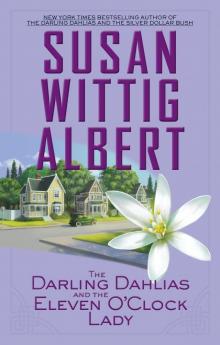 The Darling Dahlias and the Eleven O'Clock Lady
The Darling Dahlias and the Eleven O'Clock Lady